It’s the VW again, Vorthos Wednesday, the day of savoring the flavor and letting your paintbrushes dry for a few minutes.
I’ve been noticing a trend in the past few months of Magic: The Gathering artists putting their original art up for sale. The market is flooding and artists who haven’t sold their art are opening their vaults, liquidating their stores. The economy is still recovering in the United States, and artists are even more affected by the economic downturn. Art prices are lower than ever before. I’m not advocating in investing, but if you want your living space to feel less like a dorm room and/or design magazine and more like a home, start getting some art that speaks to you. Humans are all unique; shouldn’t your home reflect that? Is that Scarface poster still your reality? Really?
I’ll preface this with two truisms:
People prefer to buy good-quality art.
People prefer to pay fair prices for the art they buy.
Quality
The best collectors are the ones who spend the most time looking at art. When art is first previewed, they stare at it, examine it, and determine if it is something that they like. Quality is a result of a variety of factors after this step.
Major vs. Minor
If a collector likes a particular piece, he or she determines if it’s a major or minor work. This is not a “good or bad” valuation. Minor works are simply just not as broad in scope or as complex.
This is also not a size question. Illustrations vary in size; the original Juzam Djinn is quite small, but very important in terms of Mark Tedin’s career. Commissions tended to be smaller for shipping purposes in the past. There is a common saying in the art world: “If you can’t paint good, paint big.” This isn’t always true, but if you have a choice between a 20"×30" piece and an 11"×17", you take the smaller work.
Focus on Major Works
How does that relate to Magic? Limited cards tend to be minor works. Format-defining mythic rares tend to be major works from art directors telling artists that the piece will be used in promotional materials. You think Aleksi Briclot wasn’t informed that planeswalkers were going to be important? C’mon.
If you can only afford minor pieces by a favorite artist, it’s time to look at another artist. More often than not, minor works are overpriced and major works are underpriced. This is very common in the art world. The signature and fame of an artist does not mean that every piece is a masterpiece. Picasso has line drawings worth a mere few hundred dollars. They’re minor works. Guernica, on the other hand, is a major piece worth millions to even priceless (despite being huge).
Typical Quality
When you’re starting collecting, get a typical work like a landscape by John Avon or a Rebecca Guay blonde female. Atypical works can be a major piece of theirs and of high quality, but when you’re starting, go with what is expected. This is to be omitted when you’re dealing with an emerging artist.
Emerging Artists
Emerging art is designed by artists at the beginning of their careers. They aren’t necessarily young, but many in the commissioning scene are fairly recent graduates of art school. Most emerging art is a lower price, but the quality can still be quite high. Their goal is to have their art win awards and shown to more art directors for additional work in the future. Gaining art from new, emerging artists can be quite difficult, as their business savvy is not as established. Ryan Pancoast would be a great example.
Let’s look back in time at John Avon’s first commissions in Magic. When he was an emerging artist in 1996, he was commissioned to create these eight works:
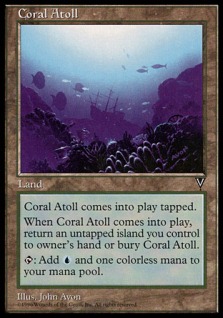 | 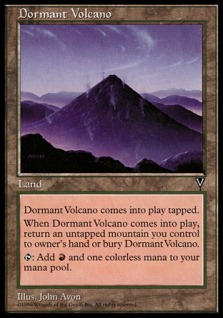 |
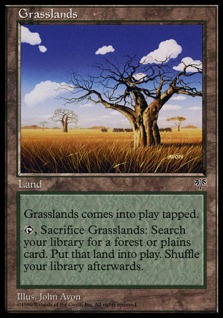 | 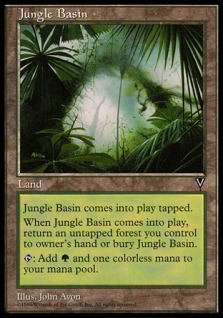 |
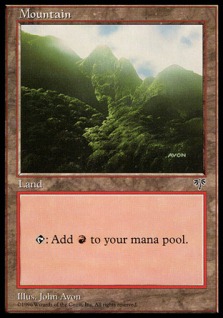 | 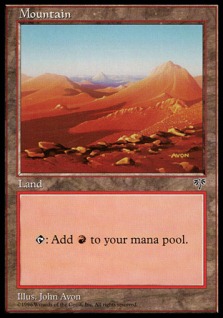 |
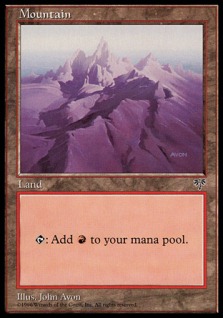 | 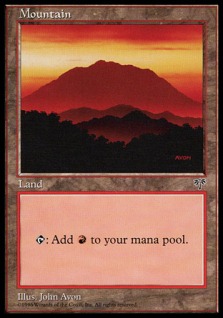 |
Landscapes are his signature Magic style, but if you’re interested in buying his art in 1996, would you consider him to be emerging? He received a lot of commissions and an entire cycle of lands. If nothing else, he likely would receive another Mountain in the future. He was thrown into the deep end and treaded the water perfectly.
But he painted a Mountain purple.
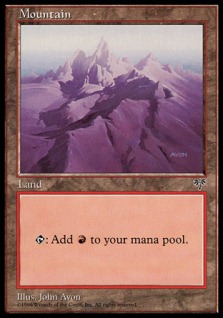
Seriously.
If a similar example were created today, I probably wouldn’t pick it up. The piece is a high-risk style, but if you love it, you get it anyway. If you love it, you’ll find a way to get it.
Only 1/1 Vanillas Are Left
The best customers get the best art for their collections; that’s all there is to it. Learn how to favorably position yourself in the art-market hierarchy in order to get special consideration when fresh art comes onto the market. You get the quality pieces first because you own other pieces. This is also very important when a piece is submitted for an art magazine like Spectrum. The art is given back to the artist; it isn’t available to the public due to the nondisclosure agreement for commissioned art.
Condition
What’s the different between two original-art Legacy staple cards, both artifacts, but one has a scratch on the Masonite board?
It’s impossible to tell, but if it’s a staple, 0% difference.
Canvases can be repaired easily (if you have the pocketbook), but watercolors, works on paper, or boards cannot be easily repaired. Artists will rarely display at conventions any damaged pieces, but I would ask about them. (Just not as an introductory conversation.) You can find A+ pieces that simply need a little help. It’s more common than you think.
A top-ten list of rules for collectors:
- Don’t keep art in extreme temperatures. This means no direct sunlight and no overly dry or damp areas.
- No smoking. Stop it.
- Frame it. Always. Protect it under glass.
- Only use professional framers. If it’s next to a pet store and across from the pretzel shop, choose another place.
- Don’t alter it. Keep the alterations to cards, not one-of-a-kind pieces.
- Examine your piece twice a year. Write a condition report on it if things have changed.
- Use only conservators if you have an issue like soda spilling on art, or a rip or serious dust. Do not call a fellow artist, or a neighbor, or anyone else. Seriously. I’ve seen paintings worth thousands destroyed by the best intentions. It becomes worse when the artists pass away. You can Google conservators; they’re all online.
- Keep the piece out of the reach of pets and babies.
Seriously, How Do You Determine Quality?
It’s always hard to tell, but the best and fastest way is to ask experts. Mind you, even information isn’t free, but if you begin a relationship with an artist representative, good things happen. I’m more than happy to e-mail anyone wishing to know more.
Fair Price
What is the real “cost” of a piece of art?
To explain the hard costs of art, it is simply the materials plus labor and demand. Clearly.
Labor
Fine-art professionals nationwide make roughly $36,000 to $66,000 per year. Numbers can be deceiving; normally, artists include their entire salary with their fantasy salary. For example, if you’re a graphic designer and do fantasy art commissions on the side, you combine them.
In Minnesota, the median income of full-time artists is $21,841.
Assistant managers at McDonalds earn roughly $25,000.
If John Avon sold every one of his paintings in 1996 for $1,000 apiece, he would gain $8,000 for two sets or 2/4 (half) of a year. It’s roughly on track and not out of line with the market at all.
What does this mean? Illustrated art, or commissioned art, tends to be cheaper than comparable art that isn’t commissioned. Also, artists are trying to make a living by selling their art. It’s helpful to see from their perspective.
Demand
Demand largely determines pricing for Magic artists. The dual-land original artworks didn’t win art awards, yet their demand and pricing are astronomical. To find out demand, research the artist and research the art. This takes weeks and should not be taken lightly. Knowing how to locate and evaluate information about art and artists is the foundation of intelligent buying. Can you find the art from a third party? The value will be higher. Is the art on a staple card? The value will be considerably higher. An entire article could be written on how to use the Internet to find this out, but every piece of art and artist differs. This process will actually be enjoyable if you love the piece you are preparing to purchase.
Same for Less
Don’t tell artists that you can get similar pieces in the same set or style for less. It irritates them, and they probably already know this. It’s better to ask, “Why does it cost this much?” Art is not making a widget; the components are not stationary.
Provenance
Provenance proves that the piece is in fact what you think it is. Some things that will help maintain the value of the piece:
- You need a signature.
- You should have a photo with the artist and the piece in your hand for insurance purposes.
- You need a sales receipt.
- You need a list of the previous owners, if there are any.
- You need to know any time the piece has been mentioned in any type of media. Ask the artist! If it was in a 1994 comic book, it’s wise to pick up the comic book.
- You should try to get the original art director’s commission. If you get a copy of the e-mail chain, you’ve won. This helps for future purchases, too.
- You should have a list of art exhibitions it has been in, if any.
- You need a certificate of authenticity.
- You need a money-back guarantee, saying that if the art is not the one you agreed to, you will be reimbursed, including sending the piece back. This happens in the gallery world more often than it should.
- You should ask if anyone ever said anything interesting or odd to the artist about the piece. Artists have elephant-like memories for things like this, because a piece of the artist is in every piece. It’s a personal process, even in creating commissions.
Not only does provenance raise the value, it increases the connection you have to the art.
I asked Inkwell Looter to sign his name and his real name on my Myr piece. He asked why, and I said that I wanted the original.
Negotiation
I don’t like doing it, but if you’re looking at a minor piece that strikes your fancy, see how long it’s been available. If it’s been on the artist’s sale list for over a year, it’s time to strike a deal. If you don’t know about the piece, don’t negotiate.
If you’re a longtime collector and you’re offered preferential treatment or told about a new piece before it goes on the market, you do not negotiate, period. You’re being given special treatment, and if you think it’s too expensive, wait a few months and see if no one snaps it up. You then have another conversation to discuss if it’s priced realistically, and the artist will probably be interested to sell it for less anyway.
Right Now
Try to pay for art in one payment; it’s nice to be unencumbered. Try not to pay in a payment plan longer than three months. Things can happen to the art in that time, or worse, you could lose your job and have months with no income. If you pay in cash at a convention, ask how it can be shipped to you. Art can take up a serious amount of space in your car or your carry-on for the flight home.
Conclusion
Buy something at every convention, every Grand Prix. Buy a print. Just do it.
I guarantee that in ten to fifteen years, you will cherish that piece of art more than you will believe. Get a Target frame and hang it up.
Forget about getting the perfect piece on your first try. Start small and have fun with it. If you like something and it catches your eye, get it. Once you start there, your second will be easier, and when you go big with an original, it’ll have friends on your favorite wall.
Stop feeling anxious and sell a fetch land to get a print. If you’re too attached to that piece of cardboard, skip lunch. If you can’t afford a piece, skip lunch and I’ll be on hand in the GenCon art area helping out to hook you up with a peanut butter and jelly. We’ll take a picture with your new print and a PB&J. On both counts, we’ll savor the flavors together.




















